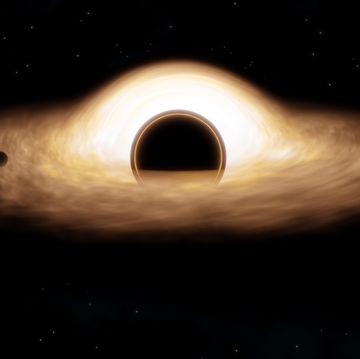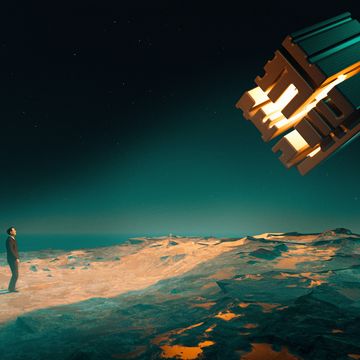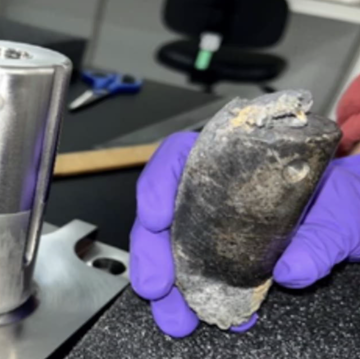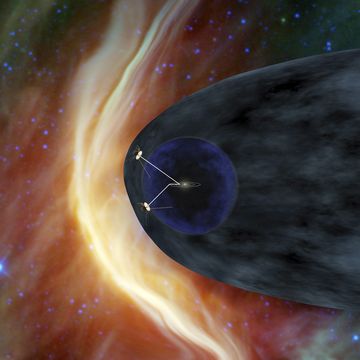Republic Aviation
 Media Platforms Design Team
Media Platforms Design TeamAs detailed in our February 1961 issue, Republic Aviation came up with this prototype lunar EVA suit. It's a little ... clunkier than what astronauts actually wore during the Apollo missions. The Republic design featured a mostly hard shell design with tripods in the event the astronaut wanted to rest. It also was built to be a whole living environment, with the astronaut having enough room to eat inside the suit.
Grumman
 Media Platforms Design Team
Media Platforms Design TeamIn 1962, Deke Slayton, a Mercury 7 astronaut who would be grounded until the mid-1970s by a heart condition, tested out this variation on the Republic moon suit. Built by Grumman, this version was designed to be tethered, with a power system and air supply attached to the lander.
Litton RX 2 suit
 Media Platforms Design Team
Media Platforms Design TeamStarting in 1963, NASA worked with Litton Industries to develop an EVA suit. Based on designs for an Air Force vacuum chamber, this was the second edition of the hard EVA suit designed by Siegfried Hansen. Very sci-fi.
Advertisement - Continue Reading Below
Apollo Prototype
 Media Platforms Design Team
Media Platforms Design TeamWhile many moon suit designs were proposed, this one was certainly one of the most unusual, featuring a very narrow field of view (likely) to protect an astronaut's eyes from the sun. It also kind of looks like the Awesome Android from Marvel Comics.
Manned Orbiting Lab
 Media Platforms Design Team
Media Platforms Design TeamWhile NASA was busy building a path to the Moon, the United States Air Force recruited its own astronaut corps to perform space reconnaissance aboard what would've been the first space station. Essentially they would have used Mercury and Apollo capsules to dock to the Manned Orbiting Lab. The station never got beyond an uncrewed prototype, but the USAF did develop the suit on the right, with a stranger helmet than the NASA compatriot on the left.
AX Suit
 Media Platforms Design Team
Media Platforms Design TeamFrom 1966 through the 1990s, NASA Ames worked on a series of hard space suits designed for greater mobility. This is one of the earlier models, from 1966. That's inventor Vic Vykukal inside.
Advertisement - Continue Reading Below
AX-3
 Media Platforms Design Team
Media Platforms Design TeamThe AX-3, demonstrated by Vic Vykukal in 1977.
AX-5
 Media Platforms Design Team
Media Platforms Design TeamThe AX-5, from a 1988 photo. Though bulkier than its predecessors, the suit was designed to give more freedom of movement to the astronaut while requiring less air pressure.
Shuttle Ejection Escape Suit
 Media Platforms Design Team
Media Platforms Design TeamThe first space shuttle astronauts were flying a kind of craft no space agency had flown before – a genuine spaceplane design. So NASA, being NASA, was exceedingly cautious about their safety, requiring crew members on STS-1 through STS-4 to wear these Shuttle Ejection Escape Suits in the event of an emergency.
The getup was based on suits worn by high-altitude Air Force jet pilots, and was designed to work in tandem with an ejection seat. The suits weren't designed for EVAs in space, but rather in case NASA had to abort a mission part of the way to space, and astronauts needed to survive an ejection from a supersonic craft.
Advertisement - Continue Reading Below
Constellation
 Media Platforms Design Team
Media Platforms Design TeamIn 2005, President George W. Bush announced the Constellation program, an audacious space exploration program that would build the first deep space rockets and crewed vehicles since the Apollo era. It included a return to the moon and a mission to Mars. While the Obama administration largely scrapped the program (save the Orion capsule and Space Launch System), some components of it were tested, including these spacesuits designed for lunar EVA.
Z-1
 Media Platforms Design Team
Media Platforms Design TeamA variant of this suit will be tested on the ISS in 2017. The Z-1 is designed to allow astronauts to change more quickly without some of the pressure issues of other suits. The spacesuit was designed by ILC Dover for NASA deep space missions.
No, you wouldn't be the first person to think it looks a bit like Buzz Lightyear's.
Z-2
 Media Platforms Design Team
Media Platforms Design TeamA variation of the Z-1, made of harder materials. Initial vacuum chamber tests will take place in 2020.
Advertisement - Continue Reading Below
BioSuit
 Media Platforms Design Team
Media Platforms Design TeamBefore becoming deputy administrator of NASA, Dava Newman made her name with the BioSuit, a design inspired by the neck muscles of giraffes. The suit regulates pressure in a way that enables it to be form fitting. MIT is creating this suit.

John Wenz is a Popular Mechanics writer and space obsessive based in Philadelphia. He tweets @johnwenz.
Advertisement - Continue Reading Below
Advertisement - Continue Reading Below
Advertisement - Continue Reading Below
















